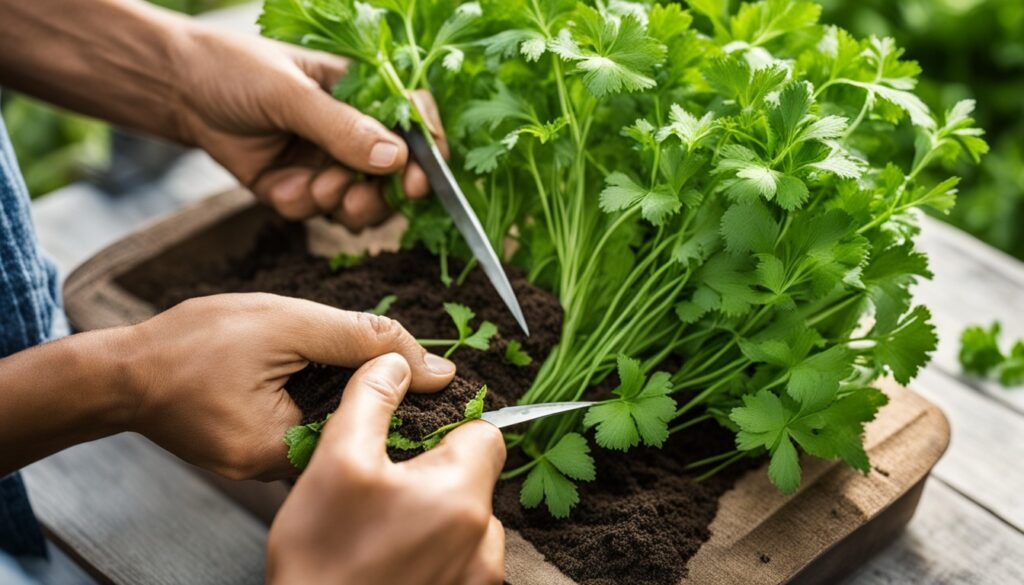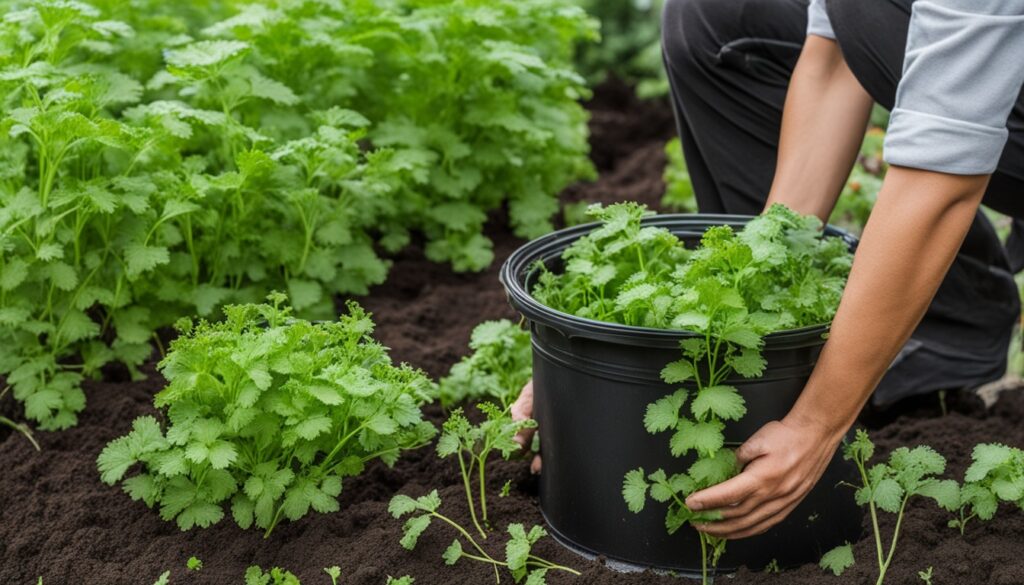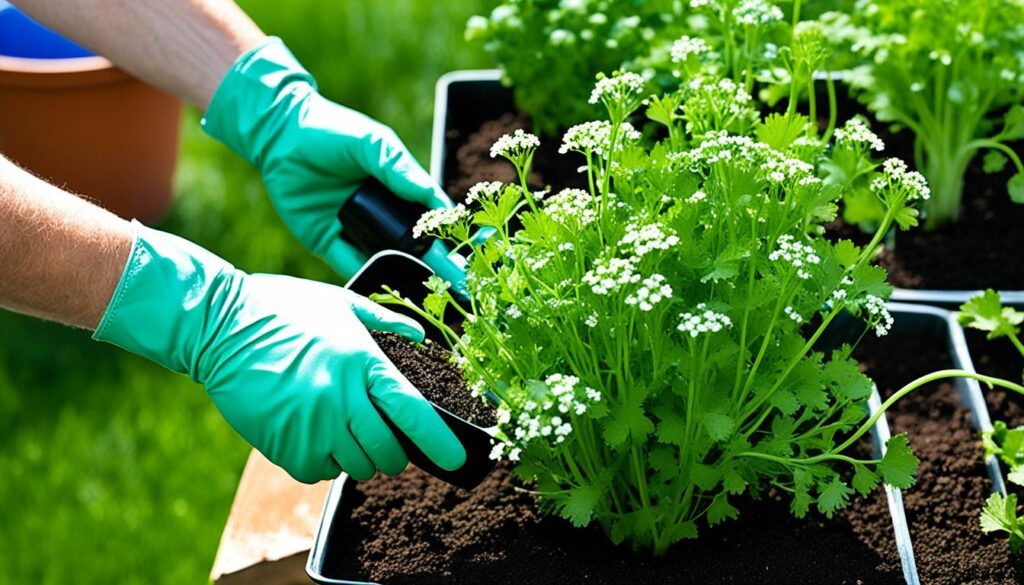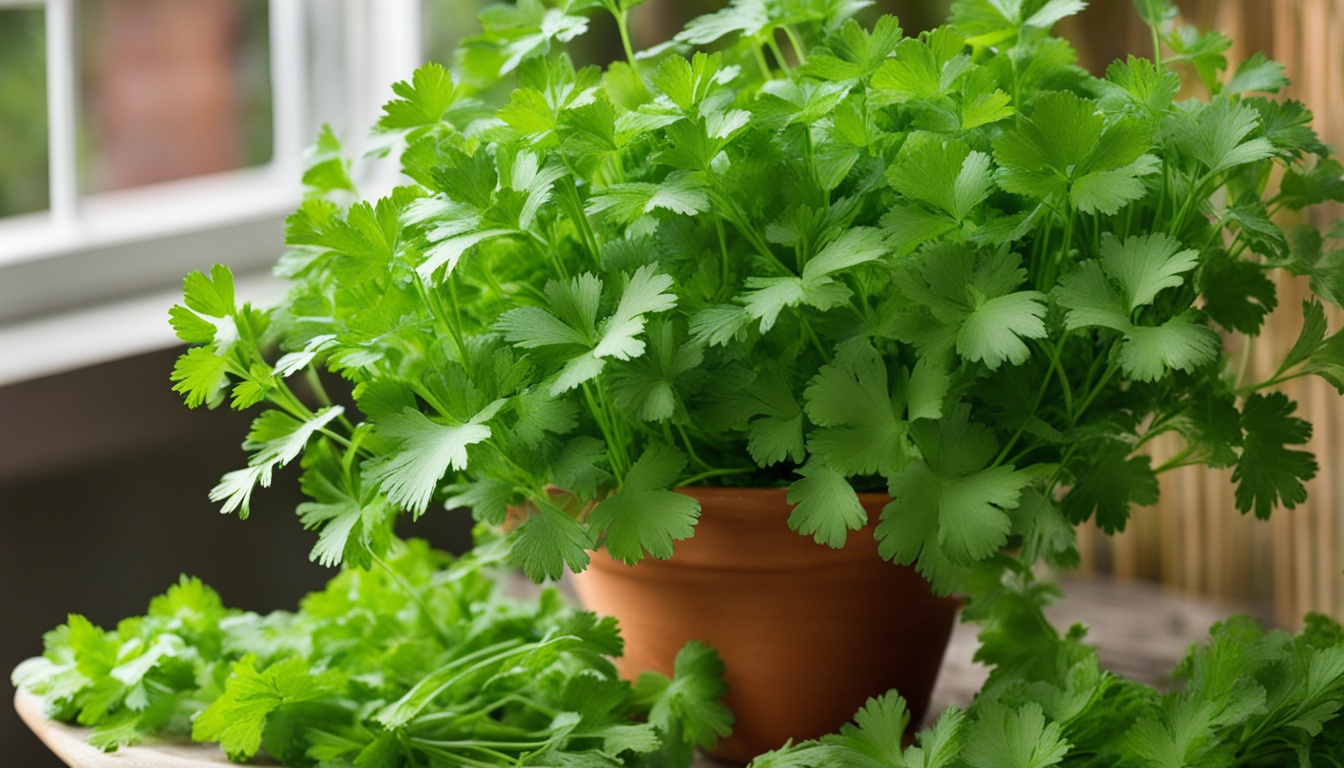I’ve learned how to harvest cilantro without harming the plant as a home gardener. Cilantro is a favorite herb for its bright taste and many uses in cooking. Yet, many gardeners find it hard to keep cilantro plants healthy all season. Here, I’ll share my tips to help you keep your cilantro plants alive and give you a steady harvest.
These tips are great for both new and seasoned gardeners. I’ll cover the plant’s growth cycle and how to harvest cilantro without killing it. With these methods, you can have a lot of cilantro for a long time.
Understanding Cilantro’s Growth Cycle
To grow cilantro well, we need to understand its growth cycle. Cilantro often bolts, meaning it goes to seed too soon. This can cut down the leaves we use in cooking. By knowing when cilantro bolts and using smart methods, we can keep harvesting it longer.
Bolting: A Natural Process
Bolting is how cilantro plants survive. When it gets more daylight, warmer, or stressed, it starts flowering and seeding instead of growing leaves. This natural process can be a problem for gardeners who want lots of cilantro.
Extending the Harvesting Window
We can make cilantro last longer with some gardening tricks. Good care like pruning, planting at the right time, and controlling the environment helps. Knowing how cilantro grows lets us keep it fresh and tasty for longer.
| Technique | Description |
|---|---|
| Succession Planting | Sow cilantro seeds every 2-3 weeks for a steady harvest, with new plants ready as others bolt. |
| Shade Provision | Keep cilantro in the shade during the hottest times to slow down bolting and keep leaves coming. |
| Temperature Control | Grow cilantro in a cool spot to avoid heat stress and early bolting. |
Using these tips, gardeners can extend cilantro’s life and have a steady supply. This shows the rewards of growing this fragrant herb.

Proper Cilantro Harvesting Techniques
Harvesting cilantro the right way is key to keeping your plants healthy and productive. I’ll explain the differences between pruning and cutting. I’ll also share tips on avoiding overcrowding for continuous growth.
Pruning vs. Cutting
Harvesting cilantro involves pruning and cutting. Pruning means taking off the outer leaves. This lets the plant grow more and produce more leaves. It also stops the plant from going to seed. Cutting the whole plant at the base gives a big harvest but might not make it grow back well.
For the best cilantro plants, prune the leaves often. This way, you get more harvests and healthier plants.
Avoiding Overcrowding
- Proper pruning is key, but don’t let your cilantro plants get too close together.
- Too many plants can lead to poor air flow, more diseases, and less food.
- Keep your cilantro plants 6-12 inches apart for good growth and air.
- Thin out and harvest regularly to stop overcrowding and keep your cilantro healthy.
Knowing how to prune and cut, and avoiding too many plants, helps you get a lot of cilantro every year.

How to Harvest Cilantro Without Killing the Plant
Harvesting cilantro can be tricky, but with the right methods, you can get a steady supply without harming the plant. It’s important to focus on the plant’s health and encourage it to grow back. Here’s how to harvest cilantro in a way that keeps your plants healthy.
The best time to pick cilantro is when the leaves are bright green and the plant is tall enough. This makes sure the plant has enough leaves to keep growing after you take some. When it’s ready, use sharp scissors or pruning shears to cut the leaves, leaving 2-3 inches of stem.
- Start by taking the outer leaves, leaving the inner ones. This helps the plant grow new leaves from the middle.
- Don’t cut the plant too low or take too much foliage at once. This can stress the plant and make it hard for it to regrow.
- Pick in the morning when the leaves are fresh and the plant is well-watered. This reduces wilting and helps the plant grow back faster.
By using these cilantro harvesting techniques, you can make your cilantro plant last longer and have a steady supply of fresh leaves. Remember, taking good care of your cilantro plant and picking at the right time are key to a lasting cilantro continuous harvest.
“The secret to a thriving cilantro plant is to harvest it mindfully, allowing the plant to regenerate and provide you with a bountiful supply for months to come.”

With a bit of care and attention, you can learn the best way to harvest cilantro without killing the plant. These simple steps will help you enjoy the benefits of your cilantro regrowth. You’ll be on your way to a sustainable cilantro cultivation that gives you a steady supply of this versatile herb.
Caring for Cilantro After Harvesting
After you harvest cilantro, taking good care of it is crucial. By doing a few simple things, you can keep your cilantro healthy and make it last longer. This way, you’ll get more harvests and enjoy your cilantro for a longer time.
One important thing is to water your cilantro plants right. They like the soil to be moist but not too wet. After you pick some, make sure to water them often. But don’t water too much, or the roots might rot.
It’s also key to feed your cilantro plants regularly. Use a balanced, water-soluble fertilizer every two to three weeks. This helps your cilantro grow and keeps it healthy for a longer time.
To keep your cilantro growing well, protect it from pests and diseases. Check your plants often for any pests or diseases. If you find any, deal with them quickly.
By following these tips, your cilantro plants will keep doing well. You’ll get lots of fresh cilantro to use in your cooking.

“Proper post-harvest care is the key to a successful, long-lasting cilantro crop.”
Troubleshooting Common Cilantro Problems
Cilantro plants can face challenges even with great care. I’ll cover common issues like pests, diseases, and environmental stress. I’ll also share solutions to keep your cilantro healthy.
Pests and Diseases
Cilantro is often attacked by pests like aphids, spider mites, and thrips. These pests can harm your plants, slowing their growth and making them look unhealthy. To fight pests, try using organic methods such as introducing beneficial insects or neem oil.
Watch out for fungal diseases like leaf spot or powdery mildew. Treat them quickly with a fungicide.
Environmental Stressors
Cilantro loves cool weather but can’t handle the heat or dryness well. High temperatures, direct sunlight, and drought can make it bolt or wilt. To keep your cilantro going, provide some shade, keep the soil moist, and mulch around the base to keep moisture in.
Also, be careful not to overwater your cilantro. This can cause problems too.
FAQ
How do I harvest cilantro without killing the plant?
I’ve learned how to harvest cilantro without harming the plant. The trick is to not cut the base. Instead, use a gentle pruning method to take just the leaves you need. This way, the plant stays healthy and keeps giving you fresh cilantro all season.
What is the best way to prune cilantro for regrowth?
Pruning cilantro right is key for it to keep growing. Don’t cut the plant too low or take too many leaves at once. Use scissors or pruning shears to clip leaves one by one, leaving 2-3 inches of stem. This trick makes the plant grow more leaves.
How do I extend the harvesting season for my cilantro plants?
To keep cilantro growing longer, know how it naturally grows. Cilantro bolts, or goes to seed, too soon. By cutting it back regularly, watering well, and keeping it shaded, you can delay bolting. This means more time to enjoy your cilantro.
How do I care for my cilantro plants after harvesting?
Taking good care of your cilantro after you harvest is key. Water them well, give them balanced fertilizer, and keep pests away. Check on them often and fix any problems fast to keep them healthy and producing.
What are some common problems I might encounter with growing cilantro?
Cilantro can face issues like pests, diseases, and stress. Watch out for aphids, insects that eat leaves, fungal diseases, and bolting from heat or drought. Knowing these problems helps you deal with them and keep your cilantro plants healthy.
